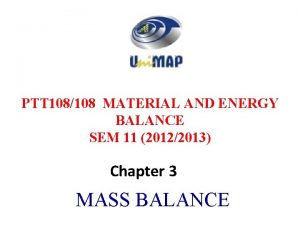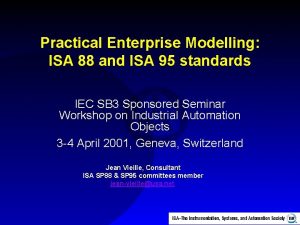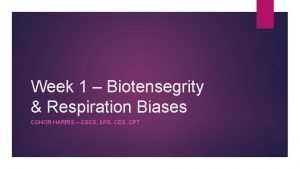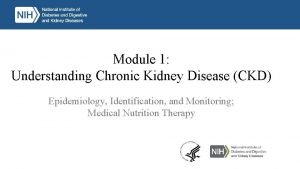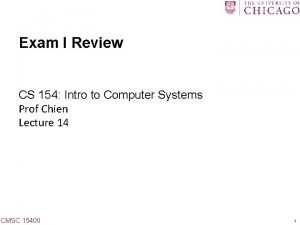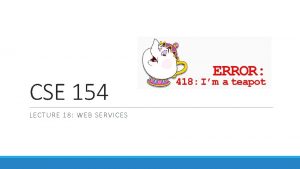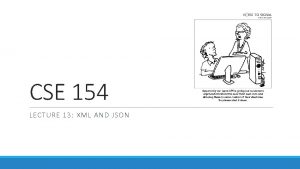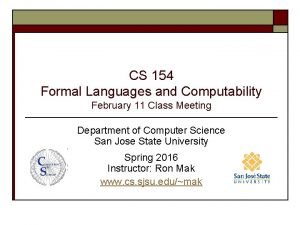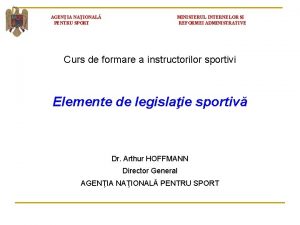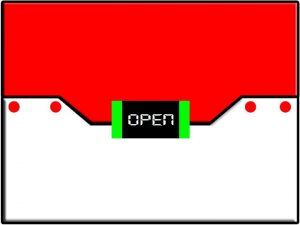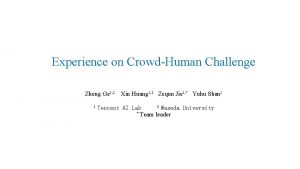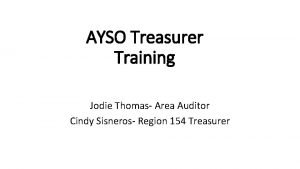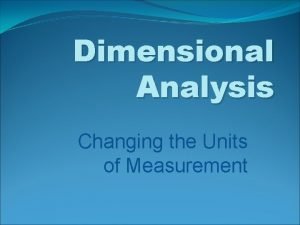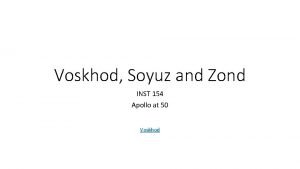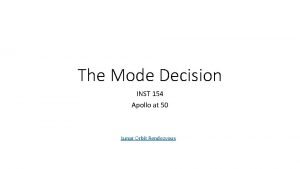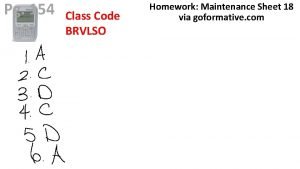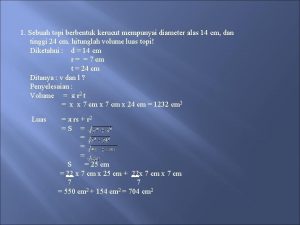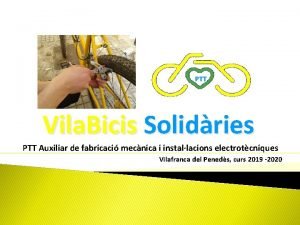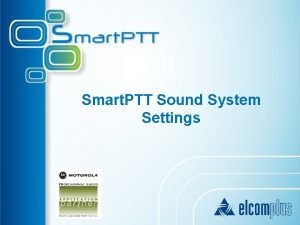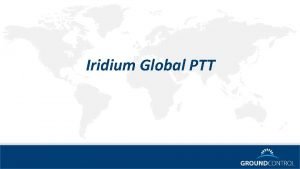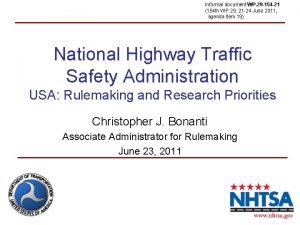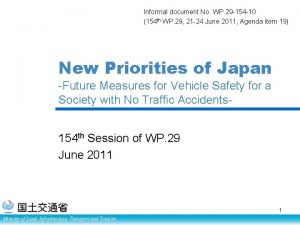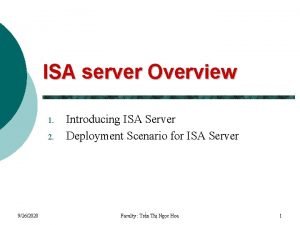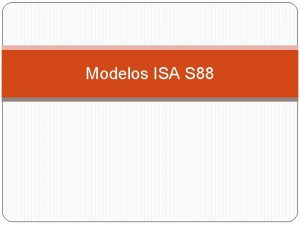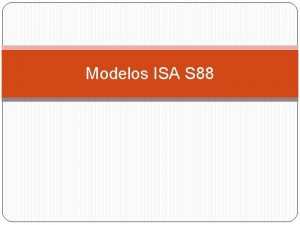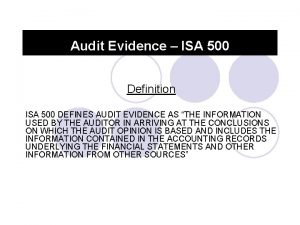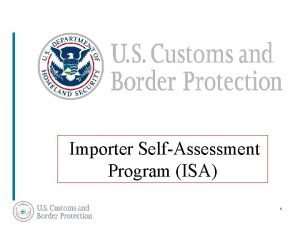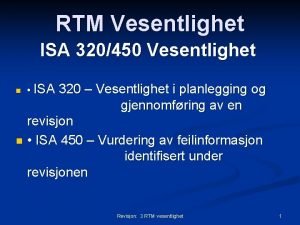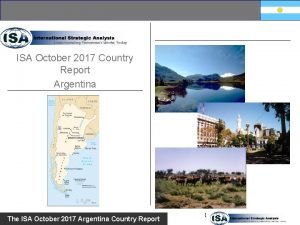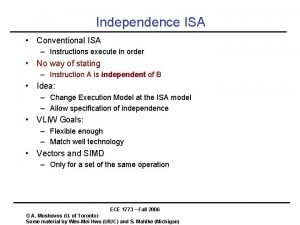Process I nstrumentation PTT 154 Introduction to ISA



















- Slides: 19

Process I nstrumentation PTT 154 Introduction to ISA Symbology

Outlines �Introduction �ISA symbology for Unit operations Valves Connections Pumps Compressors Heat exchangers

Learning Outcome: By the end of this lecture, students will be able to: �Identify ISA symbology used to show unit operations include valves, connections, pumps, compressors and heat exchangers. �To apply suitable symbol of unit operation in process flow diagram (PFD) & piping and instrumentation (P&ID)

Introduction to ISA Symbology Piping and Instrumentation Diagrams or simply P&IDs are the “schematics” used in the field of instrumentation and control (Automation) � The P&ID is used to by field techs, engineers, and operators to better understand the process and how the instrumentation is inter-connected �Being able to understand instrumentation symbols appearing on diagram means understanding ISA’s S 5. 1. �Why it is introduced? Most industries have standardized the symbols according to the ISA Standard S 5. 1 Instrumentation Symbol Specification. It is a standard developed by ISA to standardize in the field of instrumentation Each symbol is constructed using graphical elements, alpha and numeric identification, codes, abbreviations, function blocks and connecting lines �Application of ISAsymbology Process flow diagram (PFD) Process instrumentation diagram (P&ID) �

Unit Operation Distillation column Liquid mixer Stripper Absorber Reaction chamber Boiler Centrifuge Horizontal tank or cylinder Valves Pumps Compressors Heat exchangers

Unit Operation Symbols Symbol Name Description Distillation A separator unit used commonly to crack liquid contains miscellaneous component fractions. column or Liquid mixer A process unit that used to mix several components of liquid.

Unit Operation Symbols Symbol Name Description Stripper A separator unit used commonly to separate one or more component of liquid mixture by a vapor stream. Absorber A separator unit used commonly to separate one or more component of gas mixture by a liquid stream.

Unit Operation Symbols Symbol Name Description Reaction chamber A process unit where chemical process reaction occurs Horizontal tank A unit to store liquid or gas. or cylinder

Unit Operation Symbols Symbol Name Description Boiler A unit for heating. Centrifuge A separator unit that to physically mixture. (exp: liquid oil‐ ‐liquid) separated

Heat Exchanger Symbols

Compressors Symbols

Pumps Symbols

Valves Symbol Name Gate Valve Globe Valve Ball Valve Check Valve Butterfly Valve

Valves Symbol Name Relief Valve Needle Valve 3‐ ‐Way. Valve Angle Valve

Connections Symbols

Example: Production of Ethane from Ethanol is fed to continuous reactor with presence of Acid Sulphuric catalyzer to produce ethylene. Distillation process then will be applied to separate ethylene-H 2 O mixture. Ethylene as a top product is then condensate with condenser to perform liquid ethylene. Hydrogenation of ethylene applies in another reactor with presence of Nickel catalyzer to produce ethane as a final product. Given below is the block flow diagram of the process. Re-draw the diagram by applying ISA symbology.

Answer: Production of Ethane from Ethanol is fed to continuous reactor with presence of Acid Sulphuric catalyzer to produce ethylene. Distillation process then will be applied to separate ethylene-H 2 O mixture. Ethylene as a top product is then condensate with condenser to perform liquid ethylene. Hydrogenation of ethylene applies in another reactor with presence of Nickel catalyzer to produce ethane as a final product. Ethylene, CH 2 (g) Ethanol, C 2 H 5 OH H 2 SO 4 Reactor 1 CH 2 H 2 O out Hot water Ethylene liq. CH 2 (l) Cold water in Distillation column H 2 O Hydrogen, H 2 Ni Reactor 2 Ethane, CH 3

Ammonia-air mixture is feed to the bottom stream of an absorber with flow rate of 10 L/min. Water then feed to the upper stream of the same absorber with desired flow rate of 5 L/min. There are two outputs from the absorber where upper stream is insoluble NH 3 and bottom stream is NH 3 -Water mixture. This NH 3 -water mixture then feed up to a batch distillation column. The column produces ammonia gas as a top product which this product then will be condensate with a condenser to produce liquid ammonia.

Thank you
 Uso core worker process ptt
Uso core worker process ptt Isa 88 physical model
Isa 88 physical model Conor harris biomechanics
Conor harris biomechanics Efrona
Efrona Cs 154 uchicago
Cs 154 uchicago Cse 154
Cse 154 Cse 154
Cse 154 Cs 154 sjsu
Cs 154 sjsu Al baqarah 154-157
Al baqarah 154-157 Ordinul 154 din 2004
Ordinul 154 din 2004 Dodo akan memberi kado ulang tahun buat desi
Dodo akan memberi kado ulang tahun buat desi Crowdhuman
Crowdhuman Equal protection for english language learners
Equal protection for english language learners Ayso nap online
Ayso nap online Dimensional analysis steps
Dimensional analysis steps Inst-154
Inst-154 Inst-154
Inst-154 Homework 154
Homework 154 Cs 154 stanford
Cs 154 stanford Sebuah kerucut mempunyai diameter alas
Sebuah kerucut mempunyai diameter alas
